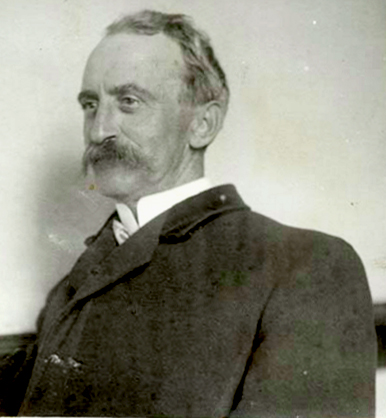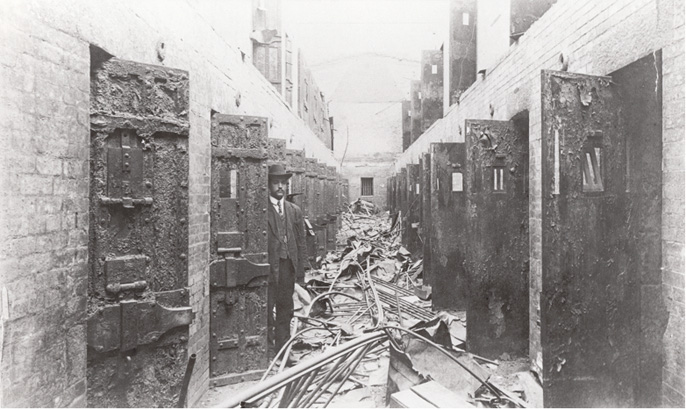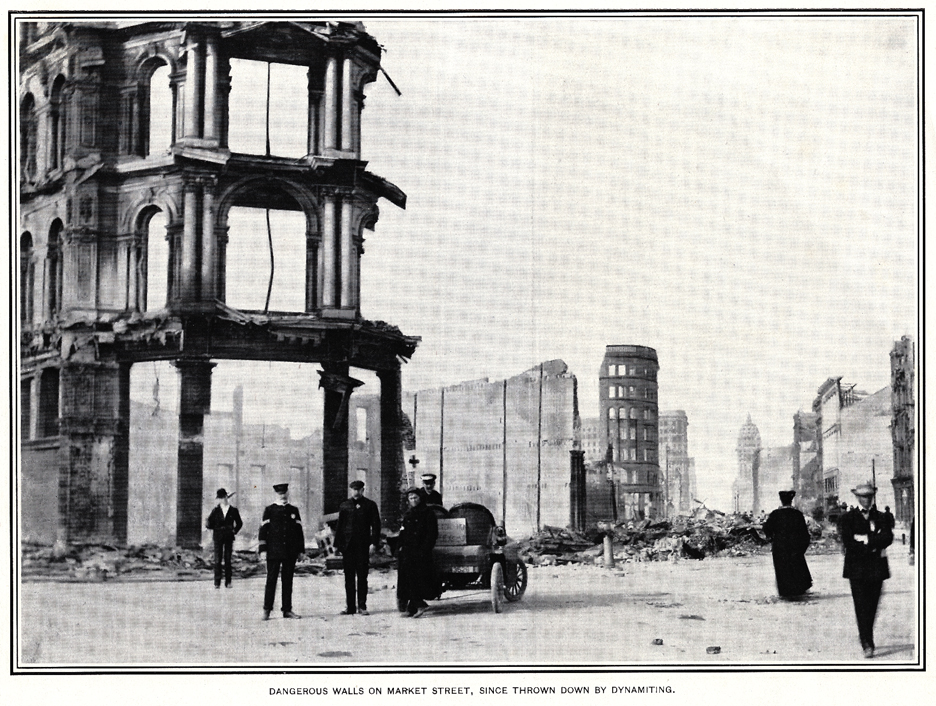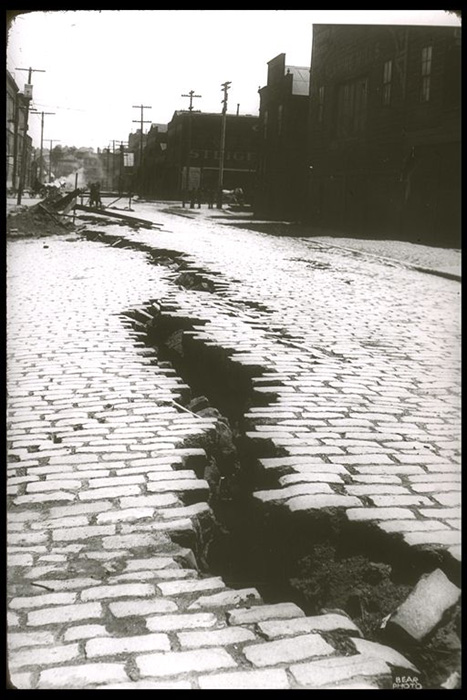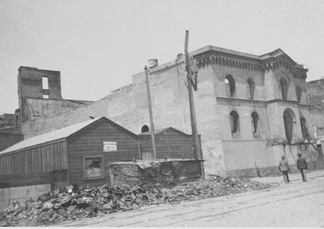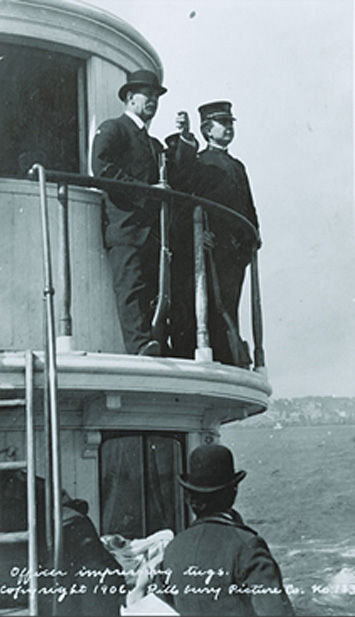April 18, 1906 is a seminal date in San Francisco history. At 5:12AM on the morning of Wednesday April 18, 1906, a 7.8 magnitude earthquake struck the San Andreas Fault with an epicenter two miles off the northern San Mateo County coast at Muscle Rock.
The event would create death and destruction in San Francisco and its immense force was felt from Los Angeles to Oregon and all the way to central Nevada.
On the morning of the 1906 earthquake the San Francisco Sheriff's Department held prisoners in three county jail locations: at the Hall of Justice at Portsmouth Square, in the Broadway Street Jail (both in the City’s North Beach neighborhood), and in two separate facilities called the Ingleside Jails on the site now occupied by City College. There was also a small holding facility in what was the new City Hall, on Market Street near Larkin, where the San Francisco Main Public Library is currently located.
Sheriff Thomas O’Neil, who ran the county jails, had been Sheriff for barely three months. O’Neil was a military veteran, having served as Commander of the California Volunteers in the Spanish-American War. As a candidate, O'Neil ran on the Union Labor Party ticket with the incumbent mayor, Eugene Schmitz.
Just prior to the great earthquake, Sheriff O’Neil had traveled by railroad to San Jose for a meeting with a number of other California Sheriffs. Since railroads throughout the State were shut down on April 18th because of the earthquake, O’Neil scrambled to find transportation back to the City. Sheriff O'Neil was was forced to travel the 47 miles back to San Francisco by hiring an automobile at a cost of one hundred dollars-- roughly the equivalent of almost $3,000 today.
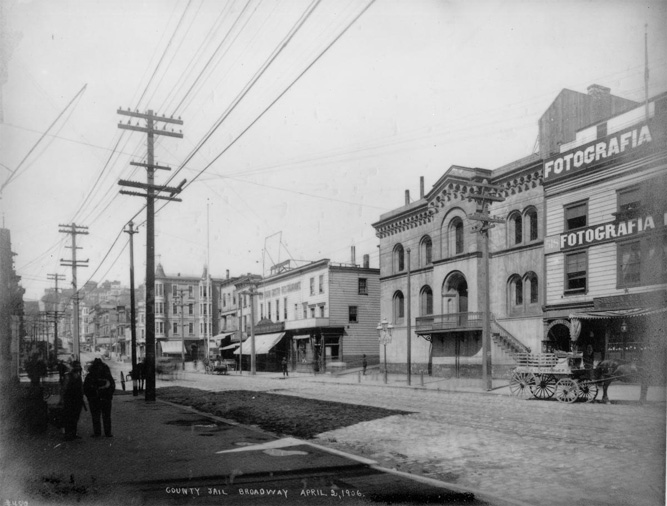
In 1851 San Francisco’s first elected Sheriff, Jack Hays, raised funds to have the City's first county jail built-- the Broadway Street Jail in North Beach. The photo above was taken looking west down Broadway toward Columbus Avenue just sixteen days prior to the 1906 earthquake. The jail is the building just right of center with wooden steps.
The County Jail was a two-story structure, sitting on a solid stone basement at the corner of Broadway and Pinkney Alley. Pinkney is now Romolo Place and today The Beat Museum stands in the exact location of the Broadway Jail. A wooden stairway on the east front of the building led to the building's front office. The jail had 60 twelve-foot long cells, each capable of holding three or four prisoners. The walls were brick, the cell doors were a heavy metal with a small window and a smaller food slot, both of which were typically closed off by hinged metal plates.
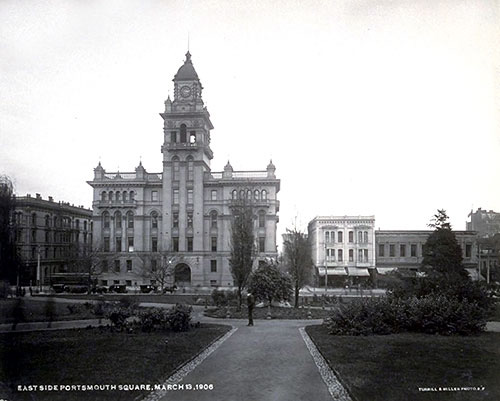
The San Francisco Hall of Justice at 750 Kearny Street between Washington and Merchant Streets. This view is looking east across Kearny from Portsmouth Square.

The ruins of the Kearny Street Hall of Justice after the 1906 earthquake. The building's structure was severely damaged and it's replacement would takes years to get done.
The Hall of Justice on Kearny Street was one of the newer City buildings, having opened only ten years earlier in 1896. A jail commonly known as City Prison occupied the top floors of the building, which housed San Francisco's criminal and civil courts and the Coronor's Office. When the massive earthquake struck at 5:12 a.m., all of San Francisco’s jails sustained serious damage.
At the Ingleside Jails across town, the women’s facility was damaged so badly that women prisoners were quickly moved to tents set up on the grounds, while the men’s facility remained habitable.
At the Broadway Street Jail what the earthquake didn’t destroy, fire and dynamite eventually did. Thus began a curious odyssey for the City's county jail prisoners and the San Francisco deputy sheriffs who watched over them.
The early morning earthquake dramatically jolted the jails, shook masonry from the walls, and bent cell doorframes, making it difficult to open the cell doors. Speaking of the Hall of Justice jail, one observer noted, “The building seemed on the verge of collapse, as it creaked and groaned like a worn-out sailing ship in a storm.” (5) Prisoner Chuck Connor recalled how prisoners “banged their fists, boots and food bowls against the bars, yelling for help.” [image6} Another prisoner, Edward Clark, recalled that shortly after the earthquake Judge Cavanaugh arrived with a police escort and ordered the release of those with minor charges.
Although the earthquake damaged both the Hall of Justice facility and the Broadway jail, they temporarily remained capable of securely holding prisoners. In fact, with City Hall in ruins, San Francisco Mayor Eugene Schmitz made the Hall of Justice his command post for most of April 18th.
National Guardsmen and other military personnel were ordered to stand guard outside the two jails to prevent escapes and to prepare for evacuation. By late in the day it was clear that one of the many out of control fires would reach both jails in a matter of hours.
Before darkness set in that evening, Mayor Schmitz moved his headquarters again, this time out of the Hall of Justice and up Nob Hill to the Fairmont Hotel.
A group of National Guardsmen were ordered to help evacuate the jails. Guardsman Elmer Enewold wrote to his father about the scene at the Broadway Jail. “It was about 3 a.m. (on April 19th) when the fire had come up within a block of the jail. The officials were getting anxious now and were going to turn all the prisoners loose, but our Captain volunteered to take them down to the Military Authorities at Fort Mason. There were about 300 of them against us 60 boys. All the murderers and hard cases were handcuffed to a long chain so they were safe from escape. The others were lined up between us fellows. We were 30 on each side. The order was given to load, fix bayonets and to shoot to kill in case any one of the prisoners attempted to break the line.”
Guardsman Enewold exaggerated the number of prisoners, but not by much. According to Sheriff O’Neil, and confirmed in military records, 77 prisoners were removed from the Hall of Justice Jail and marched four blocks to the Broadway jail where they joined 99 other prisoners, making a total of 176 prisoners to be evacuated.
The inmates were held on a wide variety of crimes, including murder, arson, robbery, burglary, assault with a deadly weapon, theft, embezzlement, forgery and a variety of other charges. Several people were booked merely “on suspicion.” At least one prisoner faced the archaic counterfeiting charge of “possession of a raised bill.”
Not long after removing the prisoners, both buildings were dynamited as part of a fruitless effort to create a firebreak. Both jails were soon engulfed in flames and destroyed completely. Metal supports melted and twisted; cell doors blackened and blistered. The grand cupola on the Hall of Justice survived the initial earthquake but not the subsequent dynamite and fire. By April 20th, the building's clock tower was hanging precariously at a ninety-degree angle.
In what must have been an amazing sight , a long line of county jail prisoners guarded by Sheriff’s deputies, National Guardsmen, and sailors, slowly made their way through the streets of North Beach toward their destination, Fort Mason along the northern waterfront. After being loaded on a launch, the entire detail sailed to San Quentin Prison only to be turned away by prison authorities. Because the San Francisco County Jail prisoners had arrived with military escort, Warden John Edgar was not convinced they were state prisoners and refused to accept them. (15)
The prisoner launch turned around and sailed back across the Bay to San Francisco, “but as it entered the harbor the thousands of persons who lined the wharves, holding out entreating arms and pleading to be taken aboard and away from the scene of destruction, caused the captain to steam away, finally landing the prisoners at Alcatraz Island.” Originally a defensive military fortress, the Alcatraz facility had been converted to a federal military prison in 1861, during the Civil War. The 176 San Francisco prisoners were accepted on an emergency basis at Alcatraz, after almost two days of marching and sailing under guard.
Along the way, at least two of the prisoners being moved hoped the earthquake and fire would work in their favor.
The more desperate of the two was local attorney and notorious bigamist George D. Collins, who was already convicted of perjury and sentenced to the maximum sentence of fourteen years in State Prison. Apparently not optimistic about his chances for an appeal, Mr. Collins attempted to escape twice during the long evacuation. When the Broadway jail was emptied out, Collins turned up missing. “A hurried search through the gloomy building on Broadway disclosed him hiding under a cot, where he had chosen to face the approaching flames rather than chance the fortunes of human justice once more.”
Later during one part of the watery transports, “a number of prisoners were separated from the Sheriff before custody of all but one was regained". Inmate Collins was missing again. Sheriff O’Neil thought it possible that Collins had jumped ship prior to docking. After what is described as “a frenzied hunt,” Collins was discovered hiding in a dark ship’s closet. (19) While Mr. Collins’ journey was far from over, he had lost his best chance to escape and would eventually loss his legal appeals, which went all the way to the United States Supreme Court. Collins was eventually transported and received at San Quentin in 1909 after years of legal maneuvering. He remained in San Quentin until his release in 1918.
Another prisoner had much better luck, likely due to much better connections. That prisoner was William F. Hopkins, nephew of the late millionaire Mark Hopkins. Although serving a ninety-day sentence for assault, within ten days of the earthquake, young Mr. Hopkins was pleased to be released after receiving a pardon signed by California Governor George Pardee.
The ongoing journey from Broadway Street and Portsmouth Square to Fort Mason, San Quentin, and then Alcatraz was not yet over San Francisco's county jail prisoners.
Beginning on April 26, and continuing for several days, the prisoners were ferried from Alcatraz across the Bay on a fireboat called The Governor Irwin to the Alameda County Jail in Oakland. The first group of fifty included those with the most serious charges, including three charged with murder. The murder suspects and a few others were shackled together, but without enough handcuffs to go around, many prisoners were merely “tied together by a long rope coiled about their waists and with a soldier at both ends of the long swaying line.”
Alameda County Sheriff Frank Barnet is quoted as saying, “ We shall be delighted to relieve Alcatraz and although we will be unable to take any more, we shall find room for these. The Alameda County Jail will be filled to its utmost capacity.”
For his part, San Francisco Sheriff Tom O’Neil was anxious to get his prisoners back to San Francisco as soon as possible. By April 28, he was proclaiming, “I expect to perfect arrangements before the end of next week for the removal of all of our prisoners now lodged in the Oakland jail back to San Francisco. Things are rapidly settling down to normal conditions on the other side of the bay… We appreciate the kindly courtesy of the Oakland authorities in caring for our group of lawbreakers, and we intend to prove our gratitude by taking them out of Oakland as soon as possible.”(23) True to his word, the Sheriff transported his the prisoners to the damaged but still functioning Ingleside Jail during the course of the next several months.
San Francisco had opened the 400-bed Ingleside Jail in 1876. In Sheriff O’Neil’s annual report after the earthquake he noted, “This building when built could never have been intended for a jail to hold men of a desperate character, such as was confined in County Jail No. 1 on Broadway Street, as the cells are entirely too small and the floors and ceilings being constructed of wood instead of iron and concrete.” By July of 1906, however, the Ingleside Jail had been reinforced considerably, including the addition of a new 120-foot long double fence. A new building addition for women prisoners was constructed in 1907.
Of course, with San Francisco’s new City Hall completely destroyed, Sheriff O’Neil and his office were displaced along with his prisoners. After the earthquake, the Office of the Sheriff was located in a gymnasium on Laguna Street between Grove and Hayes Streets. One month later, when the Superior Court established a temporary home in the Temple of Congregation Sherith-Israel on California Street, the Sheriff’s office was moved across the street from the courts to a flat at the corner of California and Webster Streets.
When the 1906 earthquake hit, San Francisco was already experiencing an earthquake of a more political nature as Mayor Schmitz, the Police Chief, and notorious political boss Abe Ruef were all indicted on charges of public corruption. Sheriff O’Neil’s close association with Mayor Schmitz and Abe Ruef sealed his fate along with all the other candidates of the tainted Union Labor Party. O'Neil was easily defeated in his 1907 bid for re-election as Sheriff.
The Broadway Jail was never rebuilt. At one time a brass plaque mounted on the outsie wall of The Beat Museum on the Romolo corner provided the revelant facts and story of San Francisco's first county jail building. The plaque has since been removed.
The Ingleside Jail continued to serve as San Francisco’s largest jail until 1934, when a "modern" new new jail was constructed and opened sixteen miles south of San Francisco on San Mateo County watershed land owned by the City and County of San Francisco in the city of San Bruno. That jail was the oldest operating county jail in California when it was replaced in August 2006. A modern new jail facility stands next to the site of the 1934 building which was torn down and removed in 2012.
The Hall of Justice was rebuilt on the Portsmouth Square site of the old building and opened in 1912. The new Kearny Street Hall had two jails-- a booking facility, City Prison run by the Police Department and a felony county jail (County Jail #1) managed by the Sheriff's Department. In 1961 the current Hall of Justice opened at 850 Bryant Street, replicating the design of the old Kearny Street building with two jails-- a booking jail (City Prison) on the 6th floor run by the Police Department, and a "felony" county jail on the 7th floor managed by the Sheriff.
In 1976 the Sheriff's Department took over management of the 6th floor booking jail ("City Prison") at the Bryant Street Hall. The old Hall of Justice site at Portsmouth Square site now offers overnight accommodations of a much different sort– a Holiday Inn.
Notes
1. “Sheriff Tells of Shake.” Oakland Tribune, April 20, 1906. Page 13.
2. Lights and Shades In San Francisco. B.E. Lloyd. Berkeley Hills Books, Berkeley, CA. 1876. Pages 135-137.
3. Denial of Disaster. Hansen, Gladys and Condon, Emmet. Cameron and Co., San Francisco, 1989. Page 16.
4. San Francisco Municipal Reports For the Fiscal Year 1905-06. Neil Publishing Co., San Francisco, 1908. Page 53.
5. The San Francisco Earthquake. Thomas, Gordon and Witts, Max Morgan. Stein and Day Publishers, New York. 1971. Page 107.
6. Ibid. Page 136.
7. San Francisco’s Great Disaster. Tyler, Sydney. The Minter Company, Harrisburg, PA. 1906. Page 23.
8. Ibid. Page 73.
9. Three Fearful Days: San Francisco Memoirs of the 1906 Earthquake and Fire. Compiled by Barker, Malcolm E. Londonborn Publications, San Francisco. 1998. Page 258.
10. San Francisco Municipal Reports For the Fiscal Year 1905-06. Neal Publishing Co., San Francisco, 1908. Page 52.
11. Fortress Alcatraz. Martini, John. Pacific Monograph, Hawaii. 1990. Page 99.
12. "Jail Prisoners Are Moved To Oakland.” The San Francisco Examiner. April 26, 1906.
13. “No Hope Left For Safety Of Any Buildings.” The San Francisco Examiner, April 19, 1906. Page 2. Also: San Francisco Municipal Reports, 1905-06. Page 52.
14. Photograph of Hall of Justice after earthquake, but before dynamite and fire. California Historical Society.
15. The San Francisco Earthquake. Page 136.
16. San Francisco’s Great Disaster. Page 231.
17. The San Francisco Earthquake. 136.
18. “Collins In Stripes, Result of Quake. Desperate Prisoner Attempts to Escape From Jailers When He Sees San Quentin Close Ahead.” The Bulletin. April 23, 1906.
19. Ibid.
20. “Collins Stays In Alcatraz Bastile. Thirty Eight Other Prisoners Removed to Oakland.” The San Francisco Examiner. April 28, 1906.
21. “Jail Prisoners Are Moved to Oakland.” SF Examiner. April 26, 1906.
22. “George D. Collins In Alameda County Jail.” The Bulletin. April 27, 1906.
23. “Sheriff Goes To Oakland.” SF Examiner. April 29, 1906.
24. San Francisco Examiner. May 3, 1906. Page 2.
25. Municipal Reports, 1905-06. Page 311.
26. “City Officials In New Offices.” The Morning Call. April 23, 1906.
27. Denial of Disaster. Pages 119, 129. Photos of both buildings.
28. “Edward R. Taylor Is Mayor; Wins By 10,000. Entire Ticket is Elected.” San Francisco Examiner. November 6, 1907. Page 1.
Photographs
Broadway Jail: 3 Photos (before, after, burned cell block)
Before: SF Public Library After: California Historical Society
Burned cells: Michael Hennessey
Hall of Justice: 3 Photos (before, after the quake/before the fire, after the fire)
Before: postcard, Michael Hennessey
Between: California Historical Society
After: Postcard/photo owned by Michael Hennessey
Sheriff O’Neil (SF State Labor Library photo from newspaper)
Soldier & Sheriffs taking control of ferry/ tug
Photo: California Historical Society

